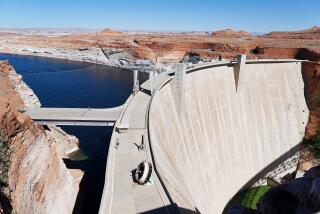Greenland ice sheet secret revealed: a chasm rivaling the Grand Canyon
While climate scientists fret over the melting of Greenland’s ice sheet, a geographer using NASA data made it disappear, revealing a canyon as long as Arizona’s Grand Canyon, buried a mile below the ice.
At 460 miles long, the chasm bests the Grand Canyon, but its deepest stretches -- 2,600 feet -- are only about half that of the grand gorges carved by the Colorado River. The unnamed canyon runs from roughly the center of the island north to the Petermann Glacier fjord.
Evidence indicates that the canyon predates the ice sheet by at least 1 million years, according to a study published this week in the journal Science. The river channel is broad but shallow, similar to the gradient of the southernmost 300 miles of the Colorado River, and three times that of the Mississippi River, according to the study.
Led by Jonathan Bamber, a geographer at the University of Bristol, researchers cobbled together decades of radar imagery, much of it from NASA’s Operation IceBridge program that studies polar ice.
Knowing the contours of the land beneath Greenland’s ice sheet helps climate researchers understand how the sheet melts and how water may be transported away. Climate researchers had wondered why they found no evidence of lakes of meltwater, as are found in Antarctica. Pools of water beneath ice sheets affect the way it melts and how fast it moves.
The researchers suggest that the central portions of the canyon may channel a good portion of meltwater via a river system that appears to have been active as far back as 3.5 million years ago. But questions remain about the hydraulics of the river system and glacier closer to the ocean.
In the final 124 miles of the canyon, for example, it is not clear whether water is universally present in the gorge, the study said. In this area, other studies have identified widespread and substantial meltwater at the bed of the ice flow, as well as sharply incised shelf channels that researchers suggest were largely carved by the action of seawater.
The authors suggested that further research may ultimately reveal that the canyon has an effect on how water is channeled near the glacier terminus, potentially directing the meltwater to a single point in these sub-ice cavities.







